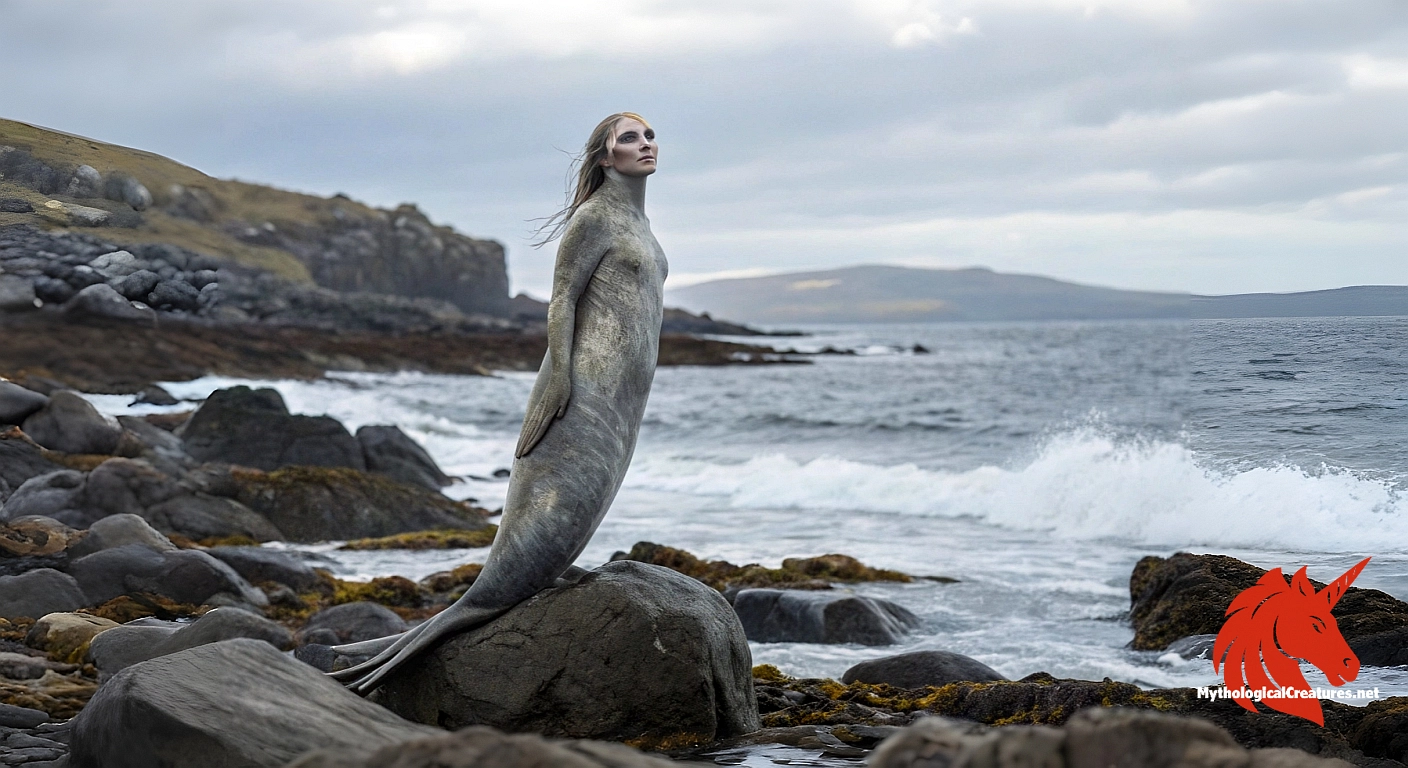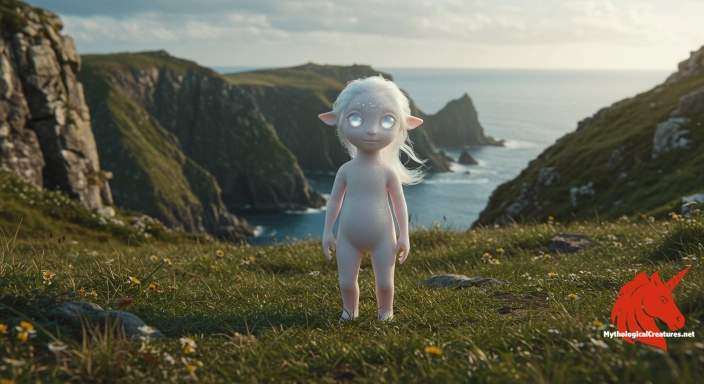Selkie: Selkies are mythological creatures capable of transforming between seal and human forms.

Selkie
Selkie - Selkies embody the tension between freedom and captivity, symbolising the connection between the natural world and human emotion through their transformative abilities and tragic romantic narratives.
Origins & First Encounters
Selkies are enchanting shapeshifters whose mystique has long captivated coastal communities, embodying the seamless transition between the realms of sea and land. Their origins are deeply rooted in ancient Celtic and Norse traditions, emerging from the rugged, windswept shores of the Northern Isles of Scotland and beyond. These beings first came to prominence in oral traditions, where the narrative of a creature capable of shedding its seal form to assume human guise evoked both wonder and caution. The dual existence of the selkie—torn between the call of the untamed ocean and the allure of human companionship—reflects broader themes of freedom and confinement in folklore. Their tales explore the poignant tension between love and loss as well as the delicate balance between natural instinct and imposed captivity. Temporal echoes in the myth suggest that selkie lore was not only a form of entertainment but also a means of interpreting the unpredictable power of nature. The act of shedding or donning a seal skin is imbued with symbolic significance, marking the threshold between two distinct worlds. Every retelling reinforces the idea that the beauty and tragedy of the selkie are intrinsically linked, capturing the imagination of all who hear their story. This rich cultural tapestry continues to be woven through generations, resonating as a timeless emblem of transformation and melancholy.
Source Texts & Tale Variants
The recorded lore of selkies extends over centuries, drawing from a multitude of primary sources that range from traditional ballads to locally preserved folktales. Oral transmissions from the Scottish isles have ensured that the story of these shapeshifters endures, while written accounts from the Norse and Irish regions supplement these narratives with additional layers of meaning. Variants of the tale have been collected by antiquarians and folklorists during the 18th and 19th centuries, each adding nuances to the central theme of transformation. A common thread throughout many of these sources is the motif of the stolen seal skin, which binds the selkie to a life on land against an inner yearning for the sea. Diverse communities have passed the story down through generations, adapting it to their local environment and cultural sensitivities. Certain narratives portray the selkie as a gentle, almost benevolent figure, while others caution that the loss of one’s skin leads to a tragic, vengeful destiny. There exists a wealth of material in which the selkie’s romantic entanglements with humans form a core element of the mythology. Iterations found in Gaelic and Norse traditions emphasise both the allure and the inherent peril of engaging with something so deeply otherworldly. Overall, these myriad accounts reflect not only a well-travelled myth but also a subject of continual reinterpretation, ensuring that the selkie remains a dynamic figure in cultural history.
Form & Powers
In its seal form, the selkie is depicted with a sleek, streamlined body that mirrors the fluid grace of ocean life, its fur glistening under the light of sun and moon alike. This natural form is characterised by a resilience honed by the rough, cold waters of the northern seas, and an elegance that belies its powerful aquatic abilities. Upon shedding its seal skin, the selkie transforms into an exceptionally attractive human figure endowed with a refined, almost ethereal beauty. The human aspect is often marked by delicate, well-proportioned features and luminous eyes that seem to reflect the shifting moods of the sea. There is an unmistakable fluidity in their movement that hints at a life lived between two worlds. Subtle elements of their marine heritage, such as a slight sheen to their skin or a texture in their hair reminiscent of sea foam, reinforce their connection to the ocean even on land. Variations in physical descriptions sometimes suggest differences in stature or colouring, with some accounts portraying them as lithe and slender, while others imbue them with a more robust, elemental charm. In many retellings, the actual transformation process is rendered with an almost magical quality, emphasising the blurring of the boundaries between the animate and the inanimate. This rich duality in physical form not only enhances their allure but also symbolises the constant interplay between captivity and freedom, a core theme of selkie mythology.
Regional Faces
The depiction of selkies is as varied as the coastal regions from which their legends originate, with each locale adapting the myth to reflect its distinct cultural landscape. In the Northern Isles of Scotland, selkies are frequently portrayed as melancholic beings whose longing is as deep as the ocean itself. Irish renditions imbue the tales with a sense of capricious magic, where the creature’s dual nature is both bewitching and perilous. Norse and Faroese traditions often introduce layers of complexity, merging the selkie lore with broader seafaring myths and the harsh realities of life in isolated, storm-battered communities. In some regional narratives, encounters with selkies celebrate a fleeting moment of beauty and mystery, while in others they serve as cautionary tales about the dangers of entangling one's fate with an otherworldly being. Variations also emerge in the methods by which humans interact with or capture the selkie, often reflecting local customs and societal values. The emphasis on the tearful parting of the selkie from its stolen skin is more pronounced in Scottish traditions, whereas Scandinavian versions may focus more on the balance of environmental forces. Even within the same cultural sphere, individual islands and communities might retell the story with slight modifications, thus ensuring that the legend remains relevant to the local experience. This regional adaptability not only testifies to the universal appeal of the selkie myth but also highlights the diverse interpretations that have allowed the legend to thrive through centuries.
Cultural Parallels
Selkie lore finds a natural kinship with numerous mythological figures across the globe, offering a rich field for cultural comparison and deeper understanding. Their dual existence, straddling the line between the human and the animal, evokes parallels to the classic sirens of Greek mythology and the mermaids celebrated in maritime legends elsewhere. Much like these counterparts, selkies embody the allure and enigma of the sea, yet they retain distinct narratives centred on personal transformation and the loss of freedom. Stories of stolen or hidden skins have resonances in other cultural traditions where the physical medium of change—whether a garment, a cloak, or a natural attribute—serves as a metaphoric bridge between two worlds. Additionally, the tale of the selkie shares common ground with other shapeshifters whose lives are defined by a tenuous balance between different states of being, highlighting universal themes of identity and metamorphosis. In some East Asian traditions, tales of metamorphic beings also explore the antagonism between human intervention and the natural world, offering an intriguing parallel to the selkie’s narrative. The contrast between the sea and the land, as symbolised by the selkie, is echoed in various mythologies where bodies of water are considered realms of both immense beauty and peril. Interwoven with these comparisons is an undercurrent that speaks to the shared human fascination with the liminal, the undetermined space between known identities. Thus, while every culture adds its own flavour to the myth, the selkie remains a uniquely compelling symbol of the perpetual dance between freedom and entrapment.
Legacy & Modern Evolution
Over the centuries, the selkie has steadily evolved from a figure of localized folklore into a broader cultural icon in modern literature, art, and popular media. Early depictions, rich in allegory and steeped in the mystique of coastal life, focused on the bittersweet nature of a creature torn between two worlds. As centuries passed, their story was reinterpreted to reflect changing societal attitudes toward nature, freedom, and identity, making the selkie a versatile metaphor for personal and environmental liberation. Contemporary storytellers often utilise the myth to explore themes of longing and the inescapable pull of one’s true home, encapsulating both beauty and underlying melancholy. Modern adaptations in film, theatre, and literature have breathed new life into the old tales, often using the selkie to discuss issues such as the loss of natural habitats and the importance of cultural heritage. The selkie’s journey from myth to modernity is marked by its flexibility, as various creative mediums reimagine the creature in ways that resonate with contemporary audiences. As digital storytelling and global communication continue to broaden the reach of these traditional narratives, the selkie remains a symbol of how folklore adapts to new cultural landscapes. The enduring appeal of the selkie underscores the timeless human fascination with the intersection of the natural and the supernatural, ensuring its legacy as one of the most evocative figures in mythological lore. By continuing to inspire reinterpretation and discussion, the selkie boldly asserts its place in both ancient memory and modern imagination.
Interesting Fact
A particularly intriguing aspect of selkie folklore is the central motif of the stolen seal skin, which serves as a potent symbol of lost freedom and the complex dynamics of romantic entanglement.
Reach myth fans
Connect your myth-driven brand with this audience
Our readers are writers, educators, gamers, and collectors who care about mythology. Enquire about a limited sponsor placement on creature pages.
Enquire about sponsorshipQuick Creature Info
Features:
Associations:
Our Mythic Legendary Rating:

Also Sometimes Known As:
Habitat:
Supernatural Powers:
Physical Attributes:
Abilities:
Behavior:
Weaknesses:
Lore:
Related Creatures, Tales or Lore
- MMermaids
- FFinfolk
References
Discover Another Mythical Legend You May Not Have Heard Of?
Uncover the mysteries of ancient folklore and expand your knowledge of legendary beings from cultures around the world.
Dare to Meet the Adhene....
Curated by the Mythological Creatures Team
Series editor: Mythological Creatures Directory
Primary desk: Northern & European Folklore Desk
(rev. November 2025)
